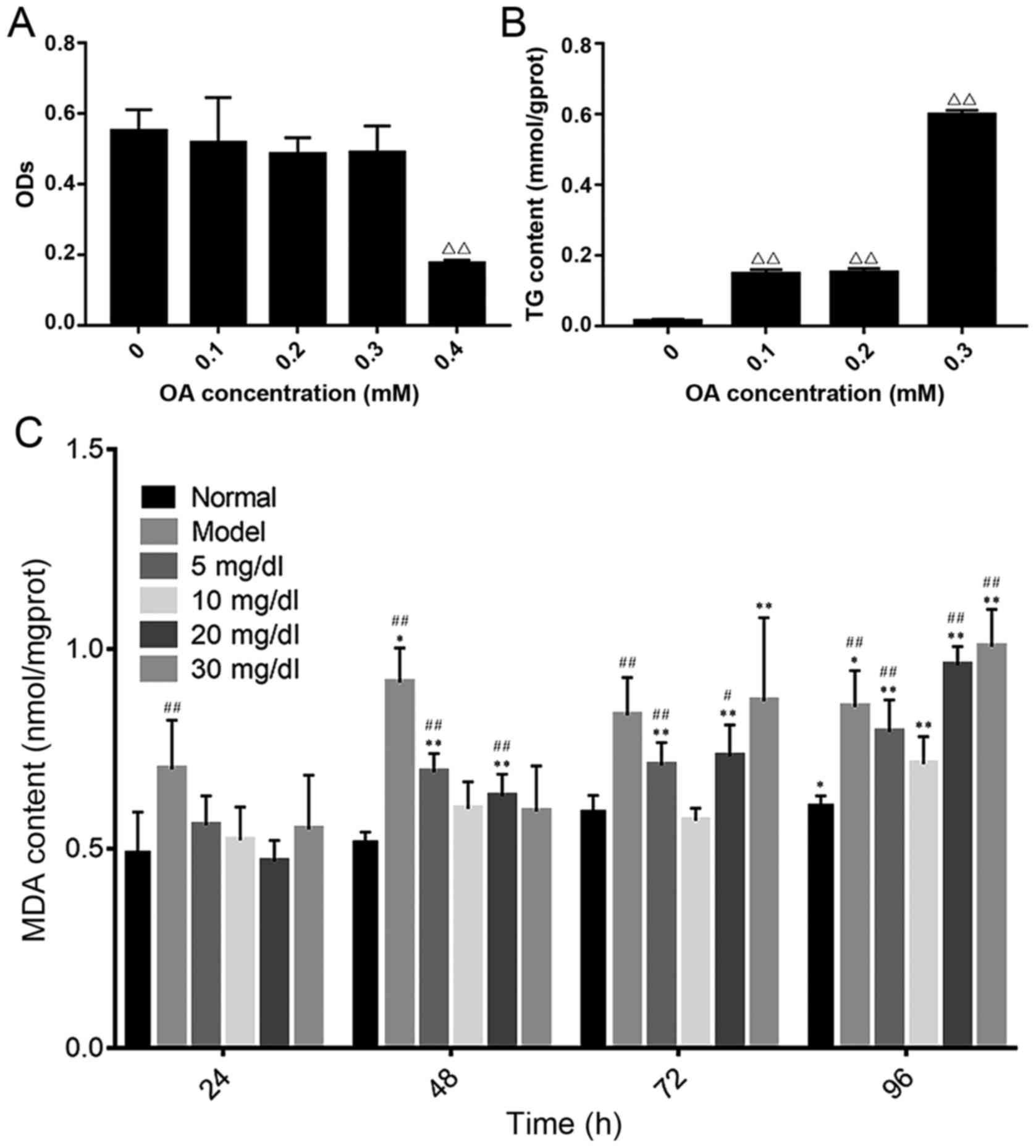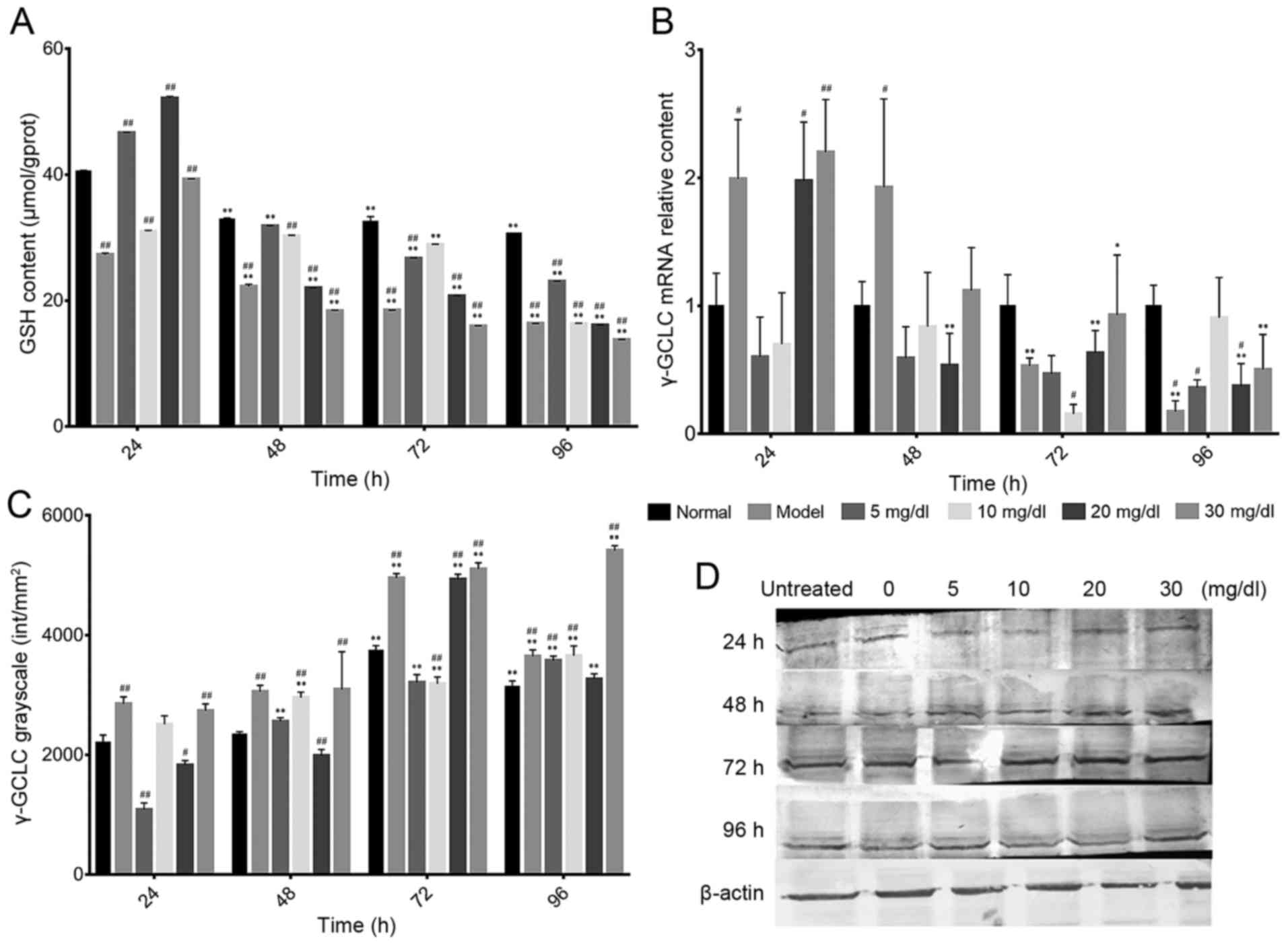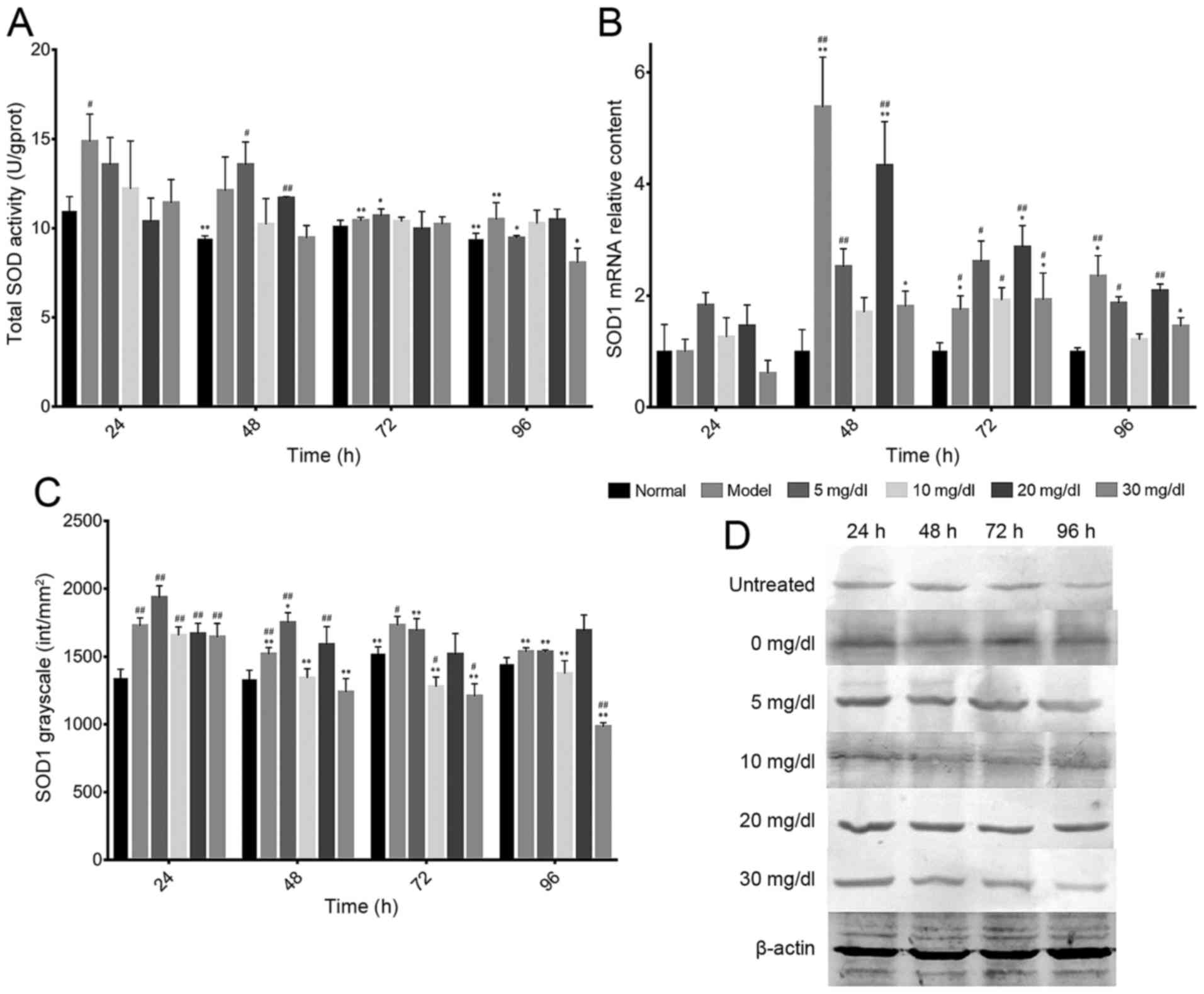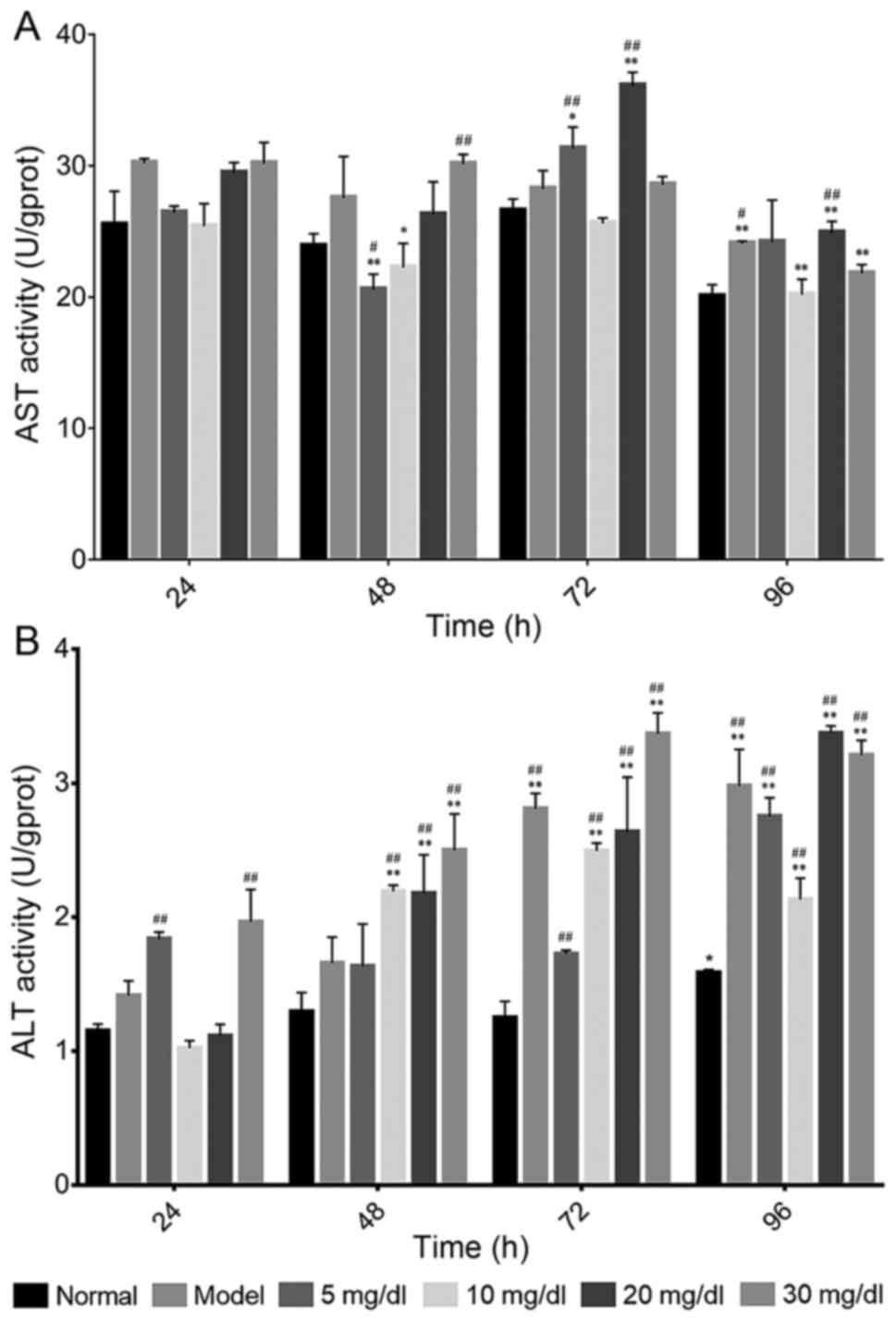|
1
|
Gori M, Simonelli MC, Giannitelli SM,
Businaro L, Trombetta M and Rainer A: Investigating nonalcoholic
fatty liver disease in a liver-on-a-chip microfluidic device. PLoS
One. 11:e01597292016. View Article : Google Scholar : PubMed/NCBI
|
|
2
|
Cheung O and Sanyal AJ: Recent advances in
nonalcoholic fatty liver disease. Curr Opin Gastroenterol.
26:202–208. 2010. View Article : Google Scholar : PubMed/NCBI
|
|
3
|
Gan L, Xiang W, Xie B and Yu L: Molecular
mechanisms of fatty liver in obesity. Front Med. 9:275–287. 2015.
View Article : Google Scholar : PubMed/NCBI
|
|
4
|
Karadeniz G, Acikgoz S, Tekin IO, Tascýlar
O, Gun BD and Cömert M: Oxidized low-density-lipoprotein
accumulation is associated with liver fibrosis in experimental
cholestasis. Clinics (Sao Paulo). 63:531–540. 2008. View Article : Google Scholar : PubMed/NCBI
|
|
5
|
Gentric G, Maillet V, Paradis V, Couton D,
L'Hermitte A, Panasyuk G, Fromenty B, Celton-Morizur S and
Desdouets C: Oxidative stress promotes pathologic polyploidization
in nonalcoholic fatty liver disease. J Clin Invest. 125:981–992.
2015. View
Article : Google Scholar : PubMed/NCBI
|
|
6
|
Fiskum G, Rosenthal RE, Vereczki V, Martin
E, Hoffman GE, Chinopoulos C and Kowaltowski A: Protection against
ischemic brain injury by inhibition of mitochondrial oxidative
stress. J Bioenerg Biomembr. 36:347–352. 2004. View Article : Google Scholar : PubMed/NCBI
|
|
7
|
Satapati S, Kucejova B, Duarte JA,
Fletcher JA, Reynolds L, Sunny NE, He T, Nair LA, Livingston KA, Fu
X, et al: Mitochondrial metabolism mediates oxidative stress and
inflammation in fatty liver. J Clin Invest. 125:4447–4462. 2015.
View Article : Google Scholar : PubMed/NCBI
|
|
8
|
Browning JD and Horton JD: Molecular
mediators of hepatic steatosis and liver injury. J Clin Invest.
114:147–152. 2004. View Article : Google Scholar : PubMed/NCBI
|
|
9
|
Xiao J, Ho CT, Liong EC, Nanji AA, Leung
TM, Lau TY, Fung ML and Tipoe GL: Epigallocatechin gallate
attenuates fibrosis, oxidative stress, and inflammation in
non-alcoholic fatty liver disease rat model through TGF/SMAD, PI3
K/Akt/FoxO1, and NF-kappa B pathways. Eur J Nutr. 53:187–199. 2014.
View Article : Google Scholar : PubMed/NCBI
|
|
10
|
Sanyal AJ, Campbell-Sargent C, Mirshahi F,
Rizzo WB, Contos MJ, Sterling RK, Luketic VA, Shiffman ML and Clore
JN: Nonalcoholic steatohepatitis: Association of insulin resistance
and mitochondrial abnormalities. Gastroenterology. 120:1183–1192.
2001. View Article : Google Scholar : PubMed/NCBI
|
|
11
|
Chalasani N, Deeg MA and Crabb DW:
Systemic levels of lipid peroxidation and its metabolic and dietary
correlates in patients with nonalcoholic steatohepatitis. Am J
Gastroenterol. 99:1497–1502. 2004. View Article : Google Scholar : PubMed/NCBI
|
|
12
|
Yesilova Z, Yaman H, Oktenli C, Ozcan A,
Uygun A, Cakir E, Sanisoglu SY, Erdil A, Ates Y, Aslan M, et al:
Systemic markers of lipid peroxidation and antioxidants in patients
with nonalcoholic Fatty liver disease. Am J Gastroenterol.
100:850–855. 2005. View Article : Google Scholar : PubMed/NCBI
|
|
13
|
Ames BN, Cathcart R, Schwiers E and
Hochstein P: Uric acid provides an antioxidant defense in humans
against oxidant- and radical-caused aging and cancer: A hypothesis.
Proc Natl Acad Sci USA. 78:pp. 6858–6862. 1981; View Article : Google Scholar : PubMed/NCBI
|
|
14
|
Bonora E, Targher G, Zenere MB, Saggiani
F, Cacciatori V, Tosi F, Travia D, Zenti MG, Branzi P, Santi L and
Muggeo M: Relationship of uric acid concentration to cardiovascular
risk factors in young men. Role of obesity and central fat
distribution. The verona young men atherosclerosis risk factors
study. Int J Obes Relat Metab Disord. 20:975–980. 1996.PubMed/NCBI
|
|
15
|
Yoo TW, Sung KC, Shin HS, Kim BJ, Kim BS,
Kang JH, Lee MH, Park JR, Kim H, Rhee EJ, et al: Relationship
between serum uric acid concentration and insulin resistance and
metabolic syndrome. Circ J. 69:928–933. 2005. View Article : Google Scholar : PubMed/NCBI
|
|
16
|
Lombardi R, Pisano G and Fargion S: Role
of serum uric acid and ferritin in the development and progression
of NAFLD. Int J Mol Sci. 17:5482016. View Article : Google Scholar : PubMed/NCBI
|
|
17
|
Wang JW, Wan XY, Zhu HT, Lu C, Yu WL, Yu
CH, Shen Z and Li YM: Lipotoxic effect of p21 on free fatty
acid-induced steatosis in L02 cells. PLoS One. 9:e961242014.
View Article : Google Scholar : PubMed/NCBI
|
|
18
|
Lanaspa MA, Sanchez-Lozada LG, Choi YJ,
Cicerchi C, Kanbay M, Roncal-Jimenez CA, Ishimoto T, Li N, Marek G,
Duranay M, et al: Uric acid induces hepatic steatosis by generation
of mitochondrial oxidative stress: Potential role in
fructose-dependent and -independent fatty liver. J Biol Chem.
287:40732–40744. 2012. View Article : Google Scholar : PubMed/NCBI
|
|
19
|
Zheng X, Gong L, Luo R, Chen H, Peng B,
Ren W and Wang Y: Serum uric acid and non-alcoholic fatty liver
disease in non-obesity Chinese adults. Lipids Health Dis.
16:2022017. View Article : Google Scholar : PubMed/NCBI
|
|
20
|
Fu YQ, Yang H, Zheng JS, Zeng XY, Zeng W,
Fan ZF, Chen M, Wang L and Li D: Positive association between
metabolic syndrome and serum uric acid in Wuhan. Asia Pac J Clin
Nutr. 26:343–350. 2017.PubMed/NCBI
|
|
21
|
Zhou Z, Song K, Qiu J, Wang Y, Liu C, Zhou
H, Xu Y, Guo Z, Zhang B and Dong C: Associations between serum Uric
acid and the remission of non-alcoholic fatty liver disease in
chinese males. PLoS One. 11:e01660722016. View Article : Google Scholar : PubMed/NCBI
|
|
22
|
Kushiyama A, Nakatsu Y, Matsunaga Y,
Yamamotoya T, Mori K, Ueda K, Inoue Y, Sakoda H, Fujishiro M, Ono H
and Asano T: Role of Uric acid metabolism-related inflammation in
the pathogenesis of metabolic syndrome components such as
atherosclerosis and nonalcoholic steatohepatitis. Mediators
Inflamm. 2016:86031642016. View Article : Google Scholar : PubMed/NCBI
|
|
23
|
Sautin YY, Nakagawa T, Zharikov S and
Johnson RJ: Adverse effects of the classic antioxidant uric acid in
adipocytes: NADPH oxidase-mediated oxidative/nitrosative stress. Am
J Physiol Cell Physiol. 293:C584–C596. 2007. View Article : Google Scholar : PubMed/NCBI
|
|
24
|
Valavanidis A, Vlachogianni T, Fiotakis K
and Loridas S: Pulmonary oxidative stress, inflammation and cancer:
Respirable particulate matter, fibrous dusts and ozone as major
causes of lung carcinogenesis through reactive oxygen species
mechanisms. Int J Environ Res Public Health. 10:3886–3907. 2013.
View Article : Google Scholar : PubMed/NCBI
|
|
25
|
Annuk M, Zilmer M, Lind L, Linde T and
Fellström B: Oxidative stress and endothelial function in chronic
renal failure. J Am Soc Nephrol. 12:2747–2752. 2001.PubMed/NCBI
|
|
26
|
Chen Y, Shertzer HG, Schneider SN, Nebert
DW and Dalton TP: Glutamate cysteine ligase catalysis: Dependence
on ATP and modifier subunit for regulation of tissue glutathione
levels. J Biol Chem. 280:33766–33772. 2005. View Article : Google Scholar : PubMed/NCBI
|
|
27
|
Vaziri ND, Dicus M, Ho ND, Boroujerdi-Rad
L and Sindhu RK: Oxidative stress and dysregulation of superoxide
dismutase and NADPH oxidase in renal insufficiency. Kidney Int.
63:179–185. 2003. View Article : Google Scholar : PubMed/NCBI
|
|
28
|
Broxton CN and Culotta VC: SOD enzymes and
microbial pathogens: Surviving the oxidative storm of infection.
PLoS Pathog. 12:e10052952016. View Article : Google Scholar : PubMed/NCBI
|
|
29
|
Kondo Y, Masutomi H, Noda Y, Ozawa Y,
Takahashi K, Handa S, Maruyama N, Shimizu T and Ishigami A:
Senescence marker protein-30/superoxide dismutase 1 double knockout
mice exhibit increased oxidative stress and hepatic steatosis. FEBS
Open Bio. 522–532. 2014. View Article : Google Scholar : PubMed/NCBI
|
|
30
|
Li XD, Sun GF, Zhu WB and Wang YH: Effects
of high intensity exhaustive exercise on SOD, MDA, and NO levels in
rats with knee osteoarthritis. Genet Mol Res. 14:12367–12376. 2015.
View Article : Google Scholar : PubMed/NCBI
|
|
31
|
Jiang J, Yu S, Jiang Z, Liang C, Yu W, Li
J, Du X, Wang H, Gao X and Wang X: N-acetyl-serotonin protects
HepG2 cells from oxidative stress injury induced by hydrogen
peroxide. Oxid Med Cell Longev. 2014:3105042014. View Article : Google Scholar : PubMed/NCBI
|
|
32
|
Zhou F, Sun W and Zhao M: Controlled
formation of emulsion gels stabilized by salted myofibrillar
protein under malondialdehyde (MDA)-induced oxidative stress. J
Agric Food Chem. 63:3766–3777. 2015. View Article : Google Scholar : PubMed/NCBI
|
|
33
|
Thulin P, Rafter I, Stockling K,
Tomkiewicz C, Norjavaara E, Aggerbeck M, Hellmold H, Ehrenborg E,
Andersson U, Cotgreave I and Glinghammar B: PPARalpha regulates the
hepatotoxic biomarker alanine aminotransferase (ALT1) gene
expression in human hepatocytes. Toxicol Appl Pharmacol. 231:1–9.
2008. View Article : Google Scholar : PubMed/NCBI
|
|
34
|
Liu L, Zhong S, Yang R, Hu H, Yu D, Zhu D,
Hua Z, Shuldiner AR, Goldstein R, Reagan WJ and Gong DW:
Expression, purification, and initial characterization of human
alanine aminotransferase (ALT) isoenzyme 1 and 2 in High-five
insect cells. Protein Expr Purif. 60:225–231. 2008. View Article : Google Scholar : PubMed/NCBI
|
|
35
|
Xu Q, Higgins T and Cembrowski GS:
Limiting the testing of AST: A diagnostically nonspecific enzyme.
Am J Clin Pathol. 144:423–426. 2015. View Article : Google Scholar : PubMed/NCBI
|


















